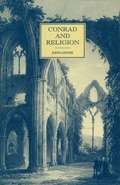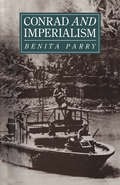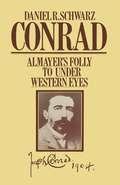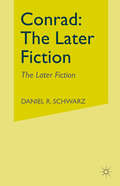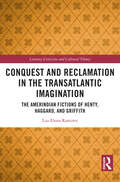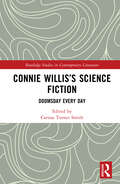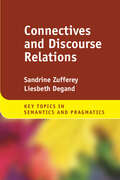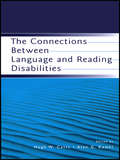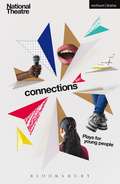- Table View
- List View
Conrad and Nature: Essays (Routledge Interdisciplinary Perspectives on Literature)
by Lissa Schneider-Rebozo Jeffrey Mathes McCarthy John G. PetersConrad and Nature is the first collection of critical essays examining nature and the environment in Joseph Conrad’s writings. Together, these essays by established and emerging scholars reveal both the crucial importance of nature in Conrad’s work, and the vital, ongoing relevance of Conrad’s treatment of the environment in our era of globalization and climate change. No richer subject matter for an environmentally-engaged criticism can be found than the Conradian contexts and themes under investigation in this volume: island cultures, colonial occupations, storms at sea, mining and extraction, inconstant weather, ecological collapse, and human communities competing for resources. The 17 essays collected here —13 new essays, and 4 excerpts from classic works of Conradian scholarship -- consolidate some of the most important voices and perspectives on Conrad’s relation to the natural world, and open new avenues for Conradian and environmental scholarship in the 21st century.
Conrad and Masculinity
by A. RobertsThis timely study offers a radical re-reading of Conrad's work in the light of contemporary theories of masculinity. Drawing on gay studies, feminism, film theory and literary theory, Roberts shows how Conrad's fiction, even as it reflects certain assumptions of its day about the role of men in society, offers striking insights into the instability of the 'masculine'. The book explores the relationship of masculinity with colonialism, modernity, the visual and the body in a wide range of Conrad's major and lesser-known fiction.
The Conquest of Ruins: The Third Reich and the Fall of Rome
by Julia HellThe Roman Empire has been a source of inspiration and a model for imitation for Western empires practically since the moment Rome fell. Yet, as Julia Hell shows in The Conquest of Ruins, what has had the strongest grip on aspiring imperial imaginations isn’t that empire’s glory but its fall—and the haunting monuments left in its wake. Hell examines centuries of European empire-building—from Charles V in the sixteenth century and Napoleon’s campaigns of the late seventeenth and early eighteenth centuries to the atrocities of Mussolini and the Third Reich in the 1930s and ’40s—and sees a similar fascination with recreating the Roman past in the contemporary image. In every case—particularly that of the Nazi regime—the ruins of Rome seem to represent a mystery to be solved: how could an empire so powerful be brought so low? Hell argues that this fascination with the ruins of greatness expresses a need on the part of would-be conquerors to find something to ward off a similar demise for their particular empire.
The Conquest of Ruins: The Third Reich and the Fall of Rome
by Julia HellThe Roman Empire has been a source of inspiration and a model for imitation for Western empires practically since the moment Rome fell. Yet, as Julia Hell shows in The Conquest of Ruins, what has had the strongest grip on aspiring imperial imaginations isn’t that empire’s glory but its fall—and the haunting monuments left in its wake. Hell examines centuries of European empire-building—from Charles V in the sixteenth century and Napoleon’s campaigns of the late seventeenth and early eighteenth centuries to the atrocities of Mussolini and the Third Reich in the 1930s and ’40s—and sees a similar fascination with recreating the Roman past in the contemporary image. In every case—particularly that of the Nazi regime—the ruins of Rome seem to represent a mystery to be solved: how could an empire so powerful be brought so low? Hell argues that this fascination with the ruins of greatness expresses a need on the part of would-be conquerors to find something to ward off a similar demise for their particular empire.
The Conquest of Ruins: The Third Reich and the Fall of Rome
by Julia HellThe Roman Empire has been a source of inspiration and a model for imitation for Western empires practically since the moment Rome fell. Yet, as Julia Hell shows in The Conquest of Ruins, what has had the strongest grip on aspiring imperial imaginations isn’t that empire’s glory but its fall—and the haunting monuments left in its wake. Hell examines centuries of European empire-building—from Charles V in the sixteenth century and Napoleon’s campaigns of the late seventeenth and early eighteenth centuries to the atrocities of Mussolini and the Third Reich in the 1930s and ’40s—and sees a similar fascination with recreating the Roman past in the contemporary image. In every case—particularly that of the Nazi regime—the ruins of Rome seem to represent a mystery to be solved: how could an empire so powerful be brought so low? Hell argues that this fascination with the ruins of greatness expresses a need on the part of would-be conquerors to find something to ward off a similar demise for their particular empire.
The Conquest of Ruins: The Third Reich and the Fall of Rome
by Julia HellThe Roman Empire has been a source of inspiration and a model for imitation for Western empires practically since the moment Rome fell. Yet, as Julia Hell shows in The Conquest of Ruins, what has had the strongest grip on aspiring imperial imaginations isn’t that empire’s glory but its fall—and the haunting monuments left in its wake. Hell examines centuries of European empire-building—from Charles V in the sixteenth century and Napoleon’s campaigns of the late seventeenth and early eighteenth centuries to the atrocities of Mussolini and the Third Reich in the 1930s and ’40s—and sees a similar fascination with recreating the Roman past in the contemporary image. In every case—particularly that of the Nazi regime—the ruins of Rome seem to represent a mystery to be solved: how could an empire so powerful be brought so low? Hell argues that this fascination with the ruins of greatness expresses a need on the part of would-be conquerors to find something to ward off a similar demise for their particular empire.
The Conquest of Ruins: The Third Reich and the Fall of Rome
by Julia HellThe Roman Empire has been a source of inspiration and a model for imitation for Western empires practically since the moment Rome fell. Yet, as Julia Hell shows in The Conquest of Ruins, what has had the strongest grip on aspiring imperial imaginations isn’t that empire’s glory but its fall—and the haunting monuments left in its wake. Hell examines centuries of European empire-building—from Charles V in the sixteenth century and Napoleon’s campaigns of the late seventeenth and early eighteenth centuries to the atrocities of Mussolini and the Third Reich in the 1930s and ’40s—and sees a similar fascination with recreating the Roman past in the contemporary image. In every case—particularly that of the Nazi regime—the ruins of Rome seem to represent a mystery to be solved: how could an empire so powerful be brought so low? Hell argues that this fascination with the ruins of greatness expresses a need on the part of would-be conquerors to find something to ward off a similar demise for their particular empire.
The Conquest of Ruins: The Third Reich and the Fall of Rome
by Julia HellThe Roman Empire has been a source of inspiration and a model for imitation for Western empires practically since the moment Rome fell. Yet, as Julia Hell shows in The Conquest of Ruins, what has had the strongest grip on aspiring imperial imaginations isn’t that empire’s glory but its fall—and the haunting monuments left in its wake. Hell examines centuries of European empire-building—from Charles V in the sixteenth century and Napoleon’s campaigns of the late seventeenth and early eighteenth centuries to the atrocities of Mussolini and the Third Reich in the 1930s and ’40s—and sees a similar fascination with recreating the Roman past in the contemporary image. In every case—particularly that of the Nazi regime—the ruins of Rome seem to represent a mystery to be solved: how could an empire so powerful be brought so low? Hell argues that this fascination with the ruins of greatness expresses a need on the part of would-be conquerors to find something to ward off a similar demise for their particular empire.
The Conquest of Rome by Matilde Serao (Pickering Women's Classics)
by Mathilde SeraoMatilde Serao (1857-1927) was a successful and prolific journalist and novelist. This book tells the story of the arrival in Rome of a provincial deputy from the poor South. It paints a portrait of political and social life in contemporary Rome.
The Conquest of Rome by Matilde Serao (Pickering Women's Classics)
by Mathilde SeraoMatilde Serao (1857-1927) was a successful and prolific journalist and novelist. This book tells the story of the arrival in Rome of a provincial deputy from the poor South. It paints a portrait of political and social life in contemporary Rome.
Conquest and Reclamation in the Transatlantic Imagination: The Amerindian Fictions of Henty, Haggard, and Griffith (Literary Criticism and Cultural Theory)
by Luz Elena RamirezThis book examines the imperial spectacles and startling reversals of fortune related in William H. Prescott's History of the Conquest of Mexico (1843) and History of the Conquest of Peru (1847), and investigates how these accounts inspired fictional adaptations by George A. Henty, H. Rider Haggard, and George Griffith. The revision of history in the Amerindian adventure both entertained young transatlantic audiences and was a vehicle to attract tourism and investment in countries such as Mexico and Peru. Henty, Haggard, and Griffith, moreover, used their tales of adventure as a platform to impart British values to their readers. Such values compel the characters and narrators of the novels discussed to act as cultural mediators, to acquire indigenous languages and adopt native ways of being, and, in several of the romance adventures under consideration, to marry Mexican or Incan noblewomen. Part I, Conquest, examines George Henty’s By Right of Conquest: Or, With Cortez in Mexico (1891), H. Rider Haggard’s Montezuma’s Daughter (1893), and George Griffith’s Virgin of the Sun: A Tale of the Conquest of Peru (1898). Part II, Reclamation, argues that English re-writings of history work to eclipse the Spanish in Haggard’s Virgin the Sun (1922), Henty’s Treasure of the Incas (1902) and Griffith’s Romance of Golden Star (1897).
Conquest and Reclamation in the Transatlantic Imagination: The Amerindian Fictions of Henty, Haggard, and Griffith (Literary Criticism and Cultural Theory)
by Luz Elena RamirezThis book examines the imperial spectacles and startling reversals of fortune related in William H. Prescott's History of the Conquest of Mexico (1843) and History of the Conquest of Peru (1847), and investigates how these accounts inspired fictional adaptations by George A. Henty, H. Rider Haggard, and George Griffith. The revision of history in the Amerindian adventure both entertained young transatlantic audiences and was a vehicle to attract tourism and investment in countries such as Mexico and Peru. Henty, Haggard, and Griffith, moreover, used their tales of adventure as a platform to impart British values to their readers. Such values compel the characters and narrators of the novels discussed to act as cultural mediators, to acquire indigenous languages and adopt native ways of being, and, in several of the romance adventures under consideration, to marry Mexican or Incan noblewomen. Part I, Conquest, examines George Henty’s By Right of Conquest: Or, With Cortez in Mexico (1891), H. Rider Haggard’s Montezuma’s Daughter (1893), and George Griffith’s Virgin of the Sun: A Tale of the Conquest of Peru (1898). Part II, Reclamation, argues that English re-writings of history work to eclipse the Spanish in Haggard’s Virgin the Sun (1922), Henty’s Treasure of the Incas (1902) and Griffith’s Romance of Golden Star (1897).
The Conquest All Over Again: Nahuas and Zapotecs Thinking, Writing, and Painting Spanish Colonialism (First Nations and the Colonial Encounter)
by Susan SchroederThe Spaniards typically portrayed the conquest and fall of Mexico Tenochtitlan as Armageddon, while native peoples in colonial Mesoamerica continued to write and paint their histories and lives often without any mention of the foreigners in their midst. Their accounts took the form of annals, chronicles, religious treatises, tribute accounts, theatre pieces, and wills. Thousand of documents were produced, almost all of which served to preserve indigenous ways of doing things. But what provoked record keeping on such a grand scale? At what point did pre-contact sacred writing become utilitarian and quotidian? Were their texts documentaries, a form of boosterism, even ingenious intellectualism, or were they ultimately a literature of ruin? This volume seeks to address key aspects of indigenous perspectives of the conquest and Spanish colonialism by examining what they themselves recorded and why they did so.
Conquered: The Last Children of Anglo-Saxon England
by Eleanor ParkerThe Norman Conquest is one of the most momentous events in English history and its consequences changed England forever. Indeed, the Battle of Hastings and its aftermath nearly wiped out the leading families of Anglo-Saxon England – so what happened to the children this conflict left behind?Conquered offers a fresh take on the Norman Conquest by exploring the lives of those children, who found themselves uprooted by the dramatic events of 1066. Among them were the children of Harold Godwineson and his brothers, survivors of a family shattered by violence who were led by their courageous grandmother Gytha to start again elsewhere. Then there were the last remaining heirs of the Anglo-Saxon royal line – Edgar Ætheling, Margaret, and Christina – who sought refuge in Scotland, where Margaret became a beloved queen and saint. Other survivors, such as Waltheof of Northumbria and Fenland hero Hereward, became legendary for rebelling against the Norman conquerors. And then there were some, like Eadmer of Canterbury, who chose to influence history by recording their own memories of the pre-conquest world.From sagas and saints' lives to chronicles and romances, Parker draws on a wide range of medieval sources to tell the stories of these young men and women and highlight the role they played in developing a new Anglo-Norman society. These tales – some reinterpreted and retold over the centuries, others carelessly forgotten over time – are ones of endurance, adaptation and vulnerability, and they all reveal a generation of young people who bravely navigated a changing world and shaped the country England was to become.
Conquered: The Last Children of Anglo-Saxon England
by Eleanor ParkerThe Norman Conquest is one of the most momentous events in English history and its consequences changed England forever. Indeed, the Battle of Hastings and its aftermath nearly wiped out the leading families of Anglo-Saxon England – so what happened to the children this conflict left behind?Conquered offers a fresh take on the Norman Conquest by exploring the lives of those children, who found themselves uprooted by the dramatic events of 1066. Among them were the children of Harold Godwineson and his brothers, survivors of a family shattered by violence who were led by their courageous grandmother Gytha to start again elsewhere. Then there were the last remaining heirs of the Anglo-Saxon royal line – Edgar Ætheling, Margaret, and Christina – who sought refuge in Scotland, where Margaret became a beloved queen and saint. Other survivors, such as Waltheof of Northumbria and Fenland hero Hereward, became legendary for rebelling against the Norman conquerors. And then there were some, like Eadmer of Canterbury, who chose to influence history by recording their own memories of the pre-conquest world.From sagas and saints' lives to chronicles and romances, Parker draws on a wide range of medieval sources to tell the stories of these young men and women and highlight the role they played in developing a new Anglo-Norman society. These tales – some reinterpreted and retold over the centuries, others carelessly forgotten over time – are ones of endurance, adaptation and vulnerability, and they all reveal a generation of young people who bravely navigated a changing world and shaped the country England was to become.
Connie Willis’s Science Fiction: Doomsday Every Day (Routledge Studies in Contemporary Literature)
by Carissa Turner SmithIn spite of Connie Willis’s numerous science fiction awards and her groundbreaking history as a woman in the field, there is a surprising dearth of critical publication surrounding her work. Taking Doomsday Book as its cue, this collection argues that Connie Willis’s most famous novel, along with the rest of her oeuvre, performs science fiction’s task of cognitive estrangement by highlighting our human inability to read the times correctly—and yet also affirming the ethical imperative to attempt to truly observe and record our temporal location. Willis’s fiction emphasizes that doomsdays happen every day, and they risk being forgotten by some, even as their trauma repeats for others. However, disasters also have the potential to upend accepted knowledge and transform the social order for the better, and this collection considers the ways that Willis pairs comic and tragic modes to reflect these uncertainties.
Connie Willis’s Science Fiction: Doomsday Every Day (Routledge Studies in Contemporary Literature)
by Carissa Turner SmithIn spite of Connie Willis’s numerous science fiction awards and her groundbreaking history as a woman in the field, there is a surprising dearth of critical publication surrounding her work. Taking Doomsday Book as its cue, this collection argues that Connie Willis’s most famous novel, along with the rest of her oeuvre, performs science fiction’s task of cognitive estrangement by highlighting our human inability to read the times correctly—and yet also affirming the ethical imperative to attempt to truly observe and record our temporal location. Willis’s fiction emphasizes that doomsdays happen every day, and they risk being forgotten by some, even as their trauma repeats for others. However, disasters also have the potential to upend accepted knowledge and transform the social order for the better, and this collection considers the ways that Willis pairs comic and tragic modes to reflect these uncertainties.
Connectives and Discourse Relations (Key Topics in Semantics and Pragmatics)
by null Sandrine Zufferey null Liesbeth DegandIllustrated with examples from a rich range of languages and genres, this book provides a state-of-the-art introduction to the meanings and functions of connectives, and the discourse relations they communicate. It begins with theoretical chapters that illustrate the many interfaces present in the study of connectives and discourse relations, using diachronic data to illustrate how connectives incorporate such a wide range of functions in synchronic language use. The second half of the book presents the rapidly growing body of studies that have used empirical data to assess theories of connectives and discourse relations, spanning fields as diverse as discourse processing, first and second language acquisition, and cross-linguistic studies. End-of-chapter discussion questions and lists of further readings are included, along with a comprehensive glossary of key terms. This title is part of the Flip it Open Programme and may also be available open access. Check our website Cambridge Core for details.
The Connections Between Language and Reading Disabilities
by Hugh W. Catts Alan G. KamhiThis is an edited book based on papers presented at a 2003 invitee-only conference under the sponsorship of the Merrill Advanced Studies Center of the University of Kansas. The participants were prominent scholars in the areas of language and reading, and have research programs funded by NIH and other sources. The purpose of the gathering was to discuss theoretical issues and research findings concerning the relationship between developmental language and reading disabilities, specifically looking at neurological, behavioral, and genetic factors. In addition, it discussed other factors contributing to reading difficulties in the middle elementary school years through adolescence and literacy outcomes for children with early language impairments, and how these problems relate to children with dyslexia. The Foreword is written by Reid Lyon, Branch Chief, Child Development and Behavior Branch, NICHD-National Institutes of Health.This book appeals to scholars in the areas of language disorders and reading disabilities, as well as to practicing speech-language pathologists, special educators, and reading specialists. It may also be used in graduate courses designed as seminars in either language disorders or reading disabilities in schools of communication disorders, as well as schools of education--especially special education departments.
The Connections Between Language and Reading Disabilities
by Hugh W. Catts Alan G. KamhiThis is an edited book based on papers presented at a 2003 invitee-only conference under the sponsorship of the Merrill Advanced Studies Center of the University of Kansas. The participants were prominent scholars in the areas of language and reading, and have research programs funded by NIH and other sources. The purpose of the gathering was to discuss theoretical issues and research findings concerning the relationship between developmental language and reading disabilities, specifically looking at neurological, behavioral, and genetic factors. In addition, it discussed other factors contributing to reading difficulties in the middle elementary school years through adolescence and literacy outcomes for children with early language impairments, and how these problems relate to children with dyslexia. The Foreword is written by Reid Lyon, Branch Chief, Child Development and Behavior Branch, NICHD-National Institutes of Health.This book appeals to scholars in the areas of language disorders and reading disabilities, as well as to practicing speech-language pathologists, special educators, and reading specialists. It may also be used in graduate courses designed as seminars in either language disorders or reading disabilities in schools of communication disorders, as well as schools of education--especially special education departments.
Connections 500: Blackout; Eclipse; What Are They Like?; Bassett; I'm Spilling My Heart Out Here; Gargantua; Children of Killers; Take Away; It Snows; The Musicians; Citizenship; Bedbug
by Snoo Wilson Simon Armitage Jackie Kay Patrick Marber Mark Ravenhill Bryony Lavery Frantic Assembly Davey Anderson James Graham Katori Hall Carl Grose Stacey Gregg Lucinda Coxon Rufus NorrisDrawing together the work of 12 leading playwrights, this National Theatre Connections anthology celebrates highlights from 21 years of the Connections festival with a retrospective selection of plays. Featuring work by some of the most prolific playwrights of the 20th and 21st centuries, and together in one volume, the anthology offers young performers between the ages of 13 and 19 an engaging selection of plays to perform, read or study.Each play has been specifically commissioned by the National Theatre's literary department over the years, with the young performer in mind. In 2016, these plays were then performed by approximately 500 schools and youth theatre companies across the UK and Ireland, in partnership with multiple professional partner regional theatres at which the works were showcased. The anthology contains all 12 of the play scripts; notes from the writer and director of each play, addressing the themes and ideas behind the play; and production notes and exercises for the drama groups.This year's anniversary anthology includes plays by Snoo Wilson, Gary Kemp and Guy Pratt; Simon Armitage; Jackie Kay; Patrick Marber; Mark Ravenhill; Bryony Lavery & Frantic Assembly; Davey Anderson; James Graham; Katori Hall; Carl Grose; Stacey Gregg; and Lucinda Coxon.
